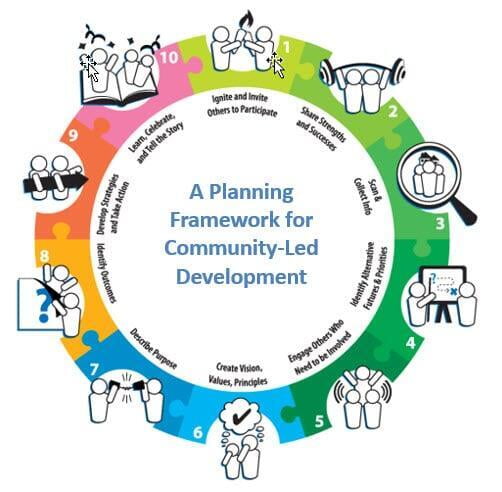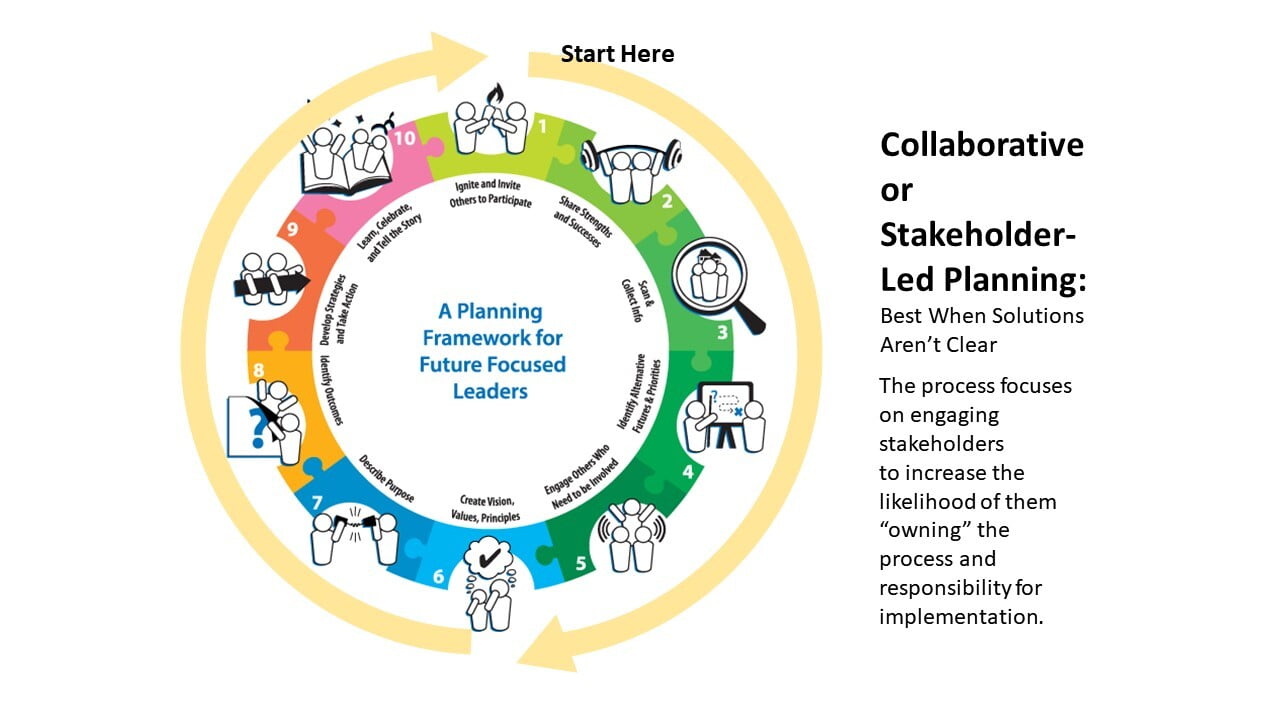A Community-Led Process and Tools for Planning

When it comes to planning, we’ve typically been taught that as leaders, our job is to solve the problem(s) – sometimes using experts – and then to develop a plan and gather or delegate to others to ensure it is implemented. This traditional or direct service delivery form of planning would typically be reflected as shown in the graphic below. In other words, ‘Let’s get the facts and take the next logical step’. Levels of stakeholder engagement varies, but control generally remains with senior leaders, elected officials, and/or hired experts.

When the solutions are clear and supported, this kind of strategic, often linear planning (or something similar) is a good fit. However, much of today’s uncertainty and ambiguity requires planning that responds to outcomes we may struggle to even articulate. Additionally, there is a growing understanding that our current systems may not be working and that we need to work across disciplines and sectors to develop new systems and structures, new economies, and new ways of being together and organizing to mobilize transformative change.

What is becoming increasingly clear is that no one can do it alone because today’s issues and their underlying root causes are far too complex for any one individual or organization to resolve on their own. Increasingly, we need to rely on networks of people, resources, organizations, businesses, and government to generate and implement innovative solutions.
Principles Guiding the Development of this Framework
This framework will be appealing if you see value in the following principles that have guided the development of this planning framework:
- More collaboration, fewer silos and a belief that government, business, and social profits can work together to ensure the multisector systems collaboration required for addressing complexity.
- An emphasis on building trusted stakeholder/citizen relationships and acknowledgement of the key role they play in determining values, outcomes, and scope for project and systems collaboration.
- Learning and knowledge exchange between a variety of stakeholders and disciplines brings the theoretical, practice-based, and/or lived experience that is essential for innovation.
- Honoring community-led development and a belief that citizens and diverse stakeholders need to be part of developing and owning solutions.
- Prioritizing balance between quality of life and economic development.
- The application of strategic foresight will help see the future more clearly.
- Collaboration requires being technology-savvy.
- Strengthening individual and organizational capacity for being nimble and good with messy is a priority.
Prioritizing Stakeholder Voices
The above principles, practice-based learnings, and applied research suggest today’s leaders -with or without a title - need to recognize that their role is not necessarily to DO the planning or try to solve the challenge or issues for those impacted. Instead, their job is more about (1) designing and supporting a PROCESS that will ensure all voices are heard, and (2) then support those stakeholders to work collaboratively to find solutions and identify a clear direction forward.
This different approach to planning requires future-focused leaders to consider, ‘How can we connect with others to: (1) apply systems-thinking and (2) strategic foresight, and to (3) mobilize ideas, people, and processes to ensure community-led development while amplifying (4) digital optimization?
The rationale for this shift in perspective is summarized in the graphic below:
Today's Planning Needs to Accommodate New Priorities
This stakeholder or community-led planning approach increases potential for success because, whether it is being applied to a project, event, program, organization, business, or entire community it:
(1) provides opportunities for stakeholders to influence decisions that affect them, their workplace, their neighbourhood, and the broader community;
(2) allows for systems-practice and strategic foresight;
(2) facilitates regular contact among stakeholders; and
(3) helps stakeholders gain the confidence to influence and take responsibility for change.
This kind of a community-led planning process (or what some would describe as a stakeholder-led process) requires 10 steps beginning at Step 1 in the graphic below.

What Makes This Framework Different?
This framework acknowledges that:
1. Planning to address complexity and the change required for innovation and transformation will need the involvement of diverse stakeholders as co-creators who are encouraged to generate and implement solutions. Steps 1-5 are designed to engage diverse representatives and encourage their ‘ownership’ for solutions and their implementation.
2. There is no one best way to plan. Instead there are multiple ways. The 10 Steps described in this framework acknowledge that each step can be carried out using various tools and resources. This reflects an understanding that each plan can find its own ‘way’ by using the tools viewed as the best fit. Each planning step has it’s own ‘library’ of tools and resources. In some ways this framework could be compared to a collection of ‘recipes’ that can be used as presented, or customized and combined using the available ‘ingredients’ for a specific occasion or situation. As with any recipe book, there will likely be recipes that may not initially appeal to a specific user. As a result, leaders are encouraged to work with their team to select the tools or resources they believe are the best fit and with which they are most comfortable. That said, experimentation and expanding one's comfort zone is also recommended. Space is provided in the template to add in the facilitative tool(s) you see as being most appropriate for your initiative.
3. Planning typically requires a process (See Steps 1-5) that will engage other diverse stakeholders and encourage their ‘ownership’ for solutions and their implementation. While it is challenging for many to staff to resist the temptation to solve the problem or address the issue themselves, it is the process that is ultimately most critical as it is what will engage and empower stakeholders.
4. The ‘messiness’ that often occurs when addressing complex issues is stressful for those who function best in a more structured, linear environment or those who want to get started on something concrete right away. As a result, beginning with a smaller team to sort out the messiness by way of ‘discovery’ and ‘defining’ before going wider to engage others has proven to be a very effective strategy for ensuring innovative, actionable, sustainable plans.
5. It is likely there are staff using a similar approach to what has been described here. Some may be doing it intuitively and therefore find it difficult to explain. It is anticipated this framework and the steps can be a means of describing a different approach.
6. It’s important to note that while the steps are numbered to indicate an ideal approach, the reality is that they may sometimes happen out of order. Regardless, most people seem to find the numbers somewhat reassuring. The challenge of organizing in a different order is that while it may sometimes work, it is perhaps less than ideal in that it can create confusion as well as result in taking more time. What is apparent is that when a step is missed, it is not unusual for the planning process to stall. In that case it is ultimately more efficient to take the time to back up and complete the missing step. On the other hand, some do-overs and revisions are inevitable in a complex process because new information or feedback may be received or opportunities can sometimes change earlier results.
We empower communities by supporting capacity for a whole-community, sector-connected approach to social, economic, and environmental well-being.

Individual and organizational future-readiness is supported increasing capacity for (1) community and stakeholder-led development, (2) systems-practices, (3) strategic foresight, and (4) digital optimization. We've learned these four components are necessary for the project and systems collaboration and informed decision-making we have experienced as being essential for transformative change and innovation.

Innovative projects require being bold, perseverance, tenacity and a sprinkle of panic.
-- Michelle Baldwin

Many situations in life are similar to going on a hike: the view changes once you start walking. You don't need all the answers right now. New paths will reveal themselves if you have the courage to get started.
--James Clear

Leadership today is about courage. Courage to realize our challenges are complex and no one individual, organization, or sector can resolve them on their own. That means we have to let go of the idea that we alone have the answers. Instead, we need to strengthen our individual and organizational competencies in order to become sector connectors who call meetings before we have the answers, aren't intimidated by messy, and can ensure a culture where all voices are heard. Only then, can our collective gifts, experience, and wisdom be focused on building a better future for all.
--Brenda Herchmer

In times of change it is the learners who inherit the future. Those who have finished learning find themselves equipped to live in a world that no longer exists.
-- Eric Hoffer

